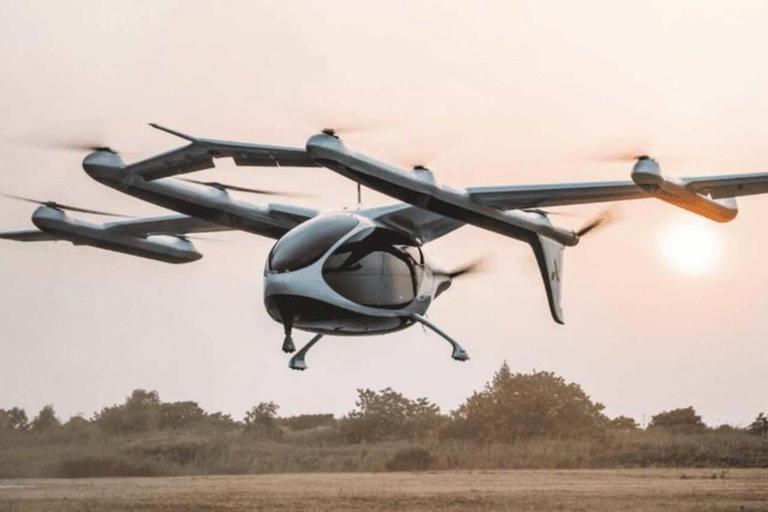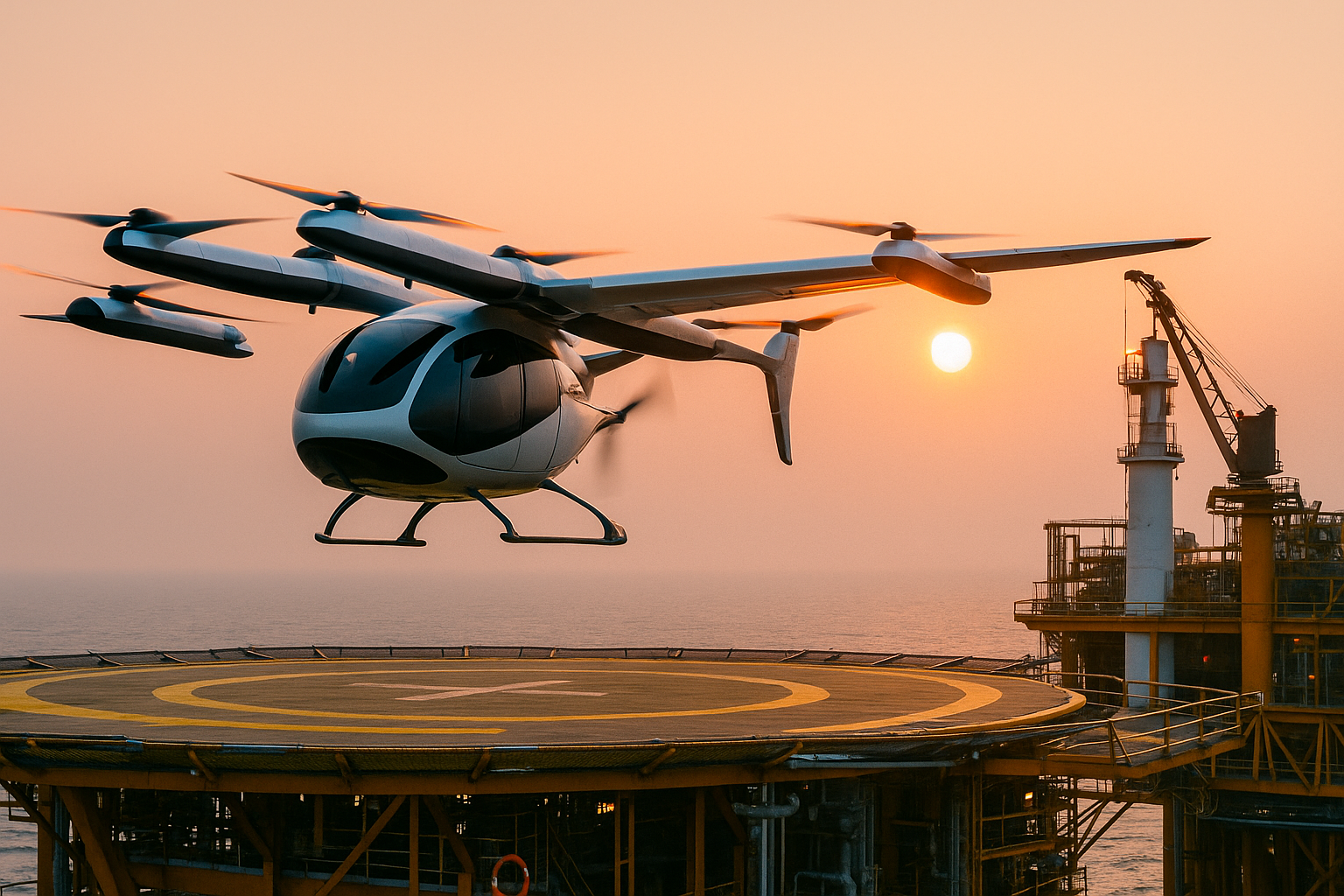On August 3, 2025, AutoFlight's CarryAll V2000CG aircraft completed a 58-minute trans-oceanic flight from Shenzhen to the Huizhou 19-3 Oil platform, located 150 kilometers offshore in the South China Sea. The mission was conducted in partnership with China National Offshore Oil Corporation (CNOOC) and CITIC Offshore Helicopters, carrying essential supplies including fresh provisions and emergency pharmaceuticals.
The flight addressed longstanding logistical constraints in offshore energy operations. Traditional maritime cargo transport to CNOOC's South China Sea platforms requires approximately 10 hours per transit, creating significant delays for critical supply deliveries and emergency response scenarios. While helicopter transport provides rapid deployment capabilities, operational costs remain prohibitively high for routine cargo operations.
AutoFlight CarryAll V2000CG Specifications

The CarryAll V2000CG represents a breakthrough in heavy-lift eVTOL technology and stands as the world's first 2-ton eVTOL to receive comprehensive certification. The aircraft incorporates an advanced Lift & Cruise configuration, delivering superior performance for cargo operations.
Technical Specifications:
| Specification | Value |
| Maximum Takeoff Weight | 2,000 kg (4,409 lb) |
| Empty Weight | 1,600 kg (3,527 lb) |
| Maximum Payload | 400 kg (882 lb) |
| Typical Range | 200-250 km (124-155 miles) |
| Maximum Velocity | 200 km/h (124 mph) |
| Cruise Speed | 200 km/h |
| Propellers | 13 (10 VTOL-only, 3 pusher) |
| Electric Motors | 13 |
| Wingspan | 14.5 m |
| Length | 11.6 m |
| Height | 2.6 m |
| Battery Capacity | 160 kWh |
| Cargo Volume | >3 cubic meters |
| Noise Level | 65 dBA in hover |
The aircraft features a carbon fiber composite fuselage for optimal strength-to-weight ratio and fixed skid landing gear. The distributed electric propulsion system provides safety through redundancy, with multiple propellers ensuring safe landing capability even if components fail. The aircraft operates autonomously without moving surfaces or tilting parts during transition from vertical to forward flight, reducing complexity and enhancing safety.
Certification Achievement
The CarryAll holds all three essential airworthiness certifications from the Civil Aviation Administration of China (CAAC): Type Certificate for design approval, Production Certificate for manufacturing authorization, and Airworthiness Certificate for individual aircraft certification. This makes it the world's first eVTOL aircraft exceeding one-ton capacity designed, manufactured, and delivered in strict accordance with civil aviation airworthiness procedures.
The certification process involved extensive testing, including 156 flights exceeding 10,000 kilometers of total flight distance across multiple locations. The aircraft has completed over 40,000 kilometers of safe flights across diverse terrains in China, the United Arab Emirates, and Japan.
Competitor Landscape
The eVTOL industry features several major players competing in different market segments, though AutoFlight's CarryAll stands out as the only fully certified 2-ton cargo-focused aircraft.
Major Competitors:
Joby Aviation S4 leads the US market with a passenger-focused eVTOL featuring a maximum takeoff weight of 2,404 kg and payload capacity of 453 kg. The aircraft offers a cruise speed of 322 km/h but a shorter range of 161 km compared to the CarryAll. Joby has secured significant partnerships with Toyota and United Airlines but remains in the certification process.
EHang EH216-S represents the closest competitor in terms of autonomous operation. However, the aircraft is significantly smaller with a maximum takeoff weight of only 620 kg and a payload of 220 kg. While it has achieved limited commercial operations in China, its 35 km range severely limits operational applications.
Archer Aviation Midnight targets urban air mobility with a 3,175 kg maximum takeoff weight and 454 kg payload. The aircraft optimizes for short 20-mile urban trips with fast turnarounds but offers only 80 km range. Despite securing partnerships with United Airlines and Southwest Airlines, certification remains pending.
Beta Technologies ALIA-250 offers the most extended range among competitors at 402 km with a 567 kg payload capacity. The aircraft features both passenger and cargo configurations but requires pilot operation and remains in the certification process.
Lilium Jet focuses on regional air mobility with 36 ducted fans and a capacity for six passengers. The aircraft matches the CarryAll's 250 km range and offers 250 km/h cruise speed, but targets passenger transport rather than cargo operations.
Context of the Low Altitude Economy
The successful offshore operation demonstrates the practical implementation of China's rapidly expanding Low Altitude Economy. The Chinese government has prioritized the development of commercial activities in airspace up to 1,000 meters above ground, with economists forecasting the industry could produce up to 2 trillion yuan ($280 billion) by 2030.
China's approach differs significantly from other markets through comprehensive government support, including infrastructure development, regulatory frameworks, and strategic investments. As of early 2025, almost 30 provincial and municipal governments have issued development plans supporting the Low Altitude Economy.
The offshore oil platform operation validates what Ren Yongyi, Deputy Manager of CNOOC's Crisis Management & Operations Support Department, described as a comprehensive "development + operation + application" framework for low-altitude economic implementation. This represents a convergence of innovative aviation technology, proven operational expertise, and real-world operational requirements.
Operational Advantages
The CarryAll's successful demonstration in the challenging South China Sea environment proved critical capabilities for offshore operations. The aircraft operated effectively despite foggy conditions, high salt mist and humidity levels, and variable strong wind conditions. Key performance validations included precision vertical operations, stable hovering performance, and extended trans-oceanic navigation.
Kellen Xie, Senior Vice President of AutoFlight, confirmed that the results validate both the technical feasibility and operational reliability of large-scale eVTOL platforms for offshore energy applications. The successful mission establishes a new paradigm for offshore logistics, offering rapid deployment capabilities at significantly lower operational costs than helicopter transport.
The demonstration flight represents more than a technological achievement—it establishes a new operational framework for the offshore energy industry. It validates the commercial viability of heavy-lift electric aviation in demanding maritime environments. As the Low Altitude Economy continues expanding globally, AutoFlight's CarryAll has positioned itself as the certified solution for cargo operations requiring the unique combination of heavy payload capacity, extended range, and all-weather operational capability.




